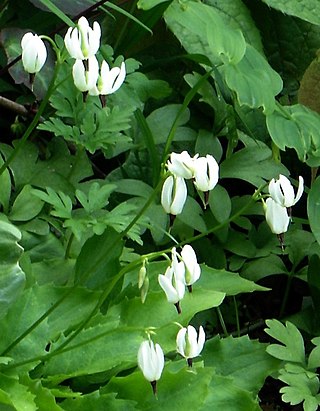
The Polygonaceae are a family of flowering plants known informally as the knotweed family or smartweed—buckwheat family in the United States. The name is based on the genus Polygonum, and was first used by Antoine Laurent de Jussieu in 1789 in his book, Genera Plantarum. The name may refer to the many swollen nodes the stems of some species have, being derived from Greek [poly meaning 'many' and gony meaning 'knee' or 'joint']. Alternatively, it may have a different origin, meaning 'many seeds'.

Primula sect. Dodecatheon is a section of herbaceous flowering plants in the family Primulaceae. Primula species in this section were formerly placed in a separate genus, Dodecatheon. The species have basal clumps of leaves and nodding flowers that are produced at the top of tall stems rising from where the leaves join the crown. The genus is largely confined to North America and part of northeastern Siberia. Common names include shooting star, American cowslip, mosquito bills, mad violets, and sailor caps. A few species are grown in gardens for their showy and unique flower display.
Paul Arnold Fryxell was an American botanist known for his work on flowering plants, especially those within the Malvaceae.

James Lauritz Reveal was a U.S. botanist best known for his contributions to the genus Eriogonum and for his work on suprageneric names. His website, at PlantSystematics.org, also presents material on plant taxonomy including the Reveal system. He published extensively on North American flora, was a member of the Angiosperm Phylogeny Group, and was one of the authors of the APG II and APG III classifications.
Rupert Charles Barneby was a British-born self-taught botanist whose primary specialty was the Fabaceae (Leguminosae), the pea family, but he also worked on Menispermaceae and numerous other groups. He was employed by the New York Botanical Garden from the 1950s until shortly before his death.

Oxytheca is a genus of plants in the family Polygonaceae with seven species found in dry and temperate parts of the Americas. The taxonomy of this genus is in flux, with some species often listed under tentative new names.

Pycnanthemum is a genus of herbaceous plants in the mint family (Lamiaceae). Species in this genus are often referred to as "mountain mints" and they often have a minty or thyme-like aroma when crushed. All species of Pycnanthemum are native to the United States and Canada. The center of diversity for the genus is North Carolina with 13 of the 20 species having been collected therein. Nineteen of the 20 species of Pycnanthemum occur in the Eastern US and Canada, and one disjunct species occurs in California and Oregon.

John Thomas Howell was an American botanist and taxonomist. He became an expert of Eriogonum (buckwheat) species, which are widely represented in the native California flora.

Primula latiloba, synonyms Dodecatheon dentatum and Dodecatheon latilobum, is a species of flowering plant in the family Primulaceae, known by the common names white shooting star and toothed American cowslip.

Dicranopteris (forkedfern) is a genus of tropical ferns of the family Gleicheniaceae. There are about 20 described species.

Cleofé Elsa Calderón was an Argentine agrostologist.
Polygonum delopyrum, the fringed jointweed or hairy jointweed, is a plant species endemic to Florida. It is found in pinelands and sandy pine barrens at elevations less than 50 m, in central and southern parts of the state.

Patricia Holmgren is an American botanist. Holmgren's main botanical interests are the flora of the U.S. intermountain west and the genera Tiarella and Thlaspi. Holmgren was the director of the herbarium at the New York Botanical Garden from 1981–2000, and editor of Index Herbariorum from 1974–2008.
Hybanthopsis is a genus of flowering plants in the violet family Violaceae, with a single accepted species, found in north-east Brazil.

Adenoa is a monotypic genus of flowering plants belonging to Turneroideae (Passifloraceae).

Aquilegia barnebyi, commonly known as the oil shale columbine or Barneby's columbine, is a perennial species of flowering plant in the buttercup family, with a native range comprising northeastern Utah and northwestern Colorado in the United States. It is named after Rupert Charles Barneby, who, with Harry Dwight Dillon Ripley, first discovered it in Colorado.
Stanmarkia is a genus of flowering plants belonging to the family Melastomataceae.
Primula standleyana, synonym Dodecatheon ellisiae, is a species of flowering plant in the family Primulaceae, native to Arizona, New Mexico and Northeast Mexico. It was first described by Paul Carpenter Standley in 1913 as Dodecatheon ellisiae. When the genus Dodecatheon was reduced to Primula sect. Dodecatheon following molecular phylogenetic studies, the species could not be transferred to Primula as Primula ellisiae, as that name had already been used for a different species. Accordingly, the replacement name Primula standleyana was provided.
Primula utahensis, synonym Dodecatheon utahense, is a species of flowering plant in the family Primulaceae, native to Utah. It was first described by Noel Holmgren in 1994 as Dodecatheon dentatum var. utahense. In 2006, it was raised to a separate species as Dodecatheon utahense. When Dodecatheon was sunk into Primula in 2007, it was transferred to that genus as Primula utahensis.

Aglaomorpha willdenowii is a species of subtropical fern native to the islands of Comoros, Madagascar, and Mauritius. Drynarioid ferns are largely native to Asia and Oceania, but A. willdenowii is the only species of fern in the genus native to Madagascar. Like other Aglaomorpha, its caudex is covered in dry, scale-like sterile fronds and fine hairs, while the larger green fronds are the fertile ones bearing spores.












